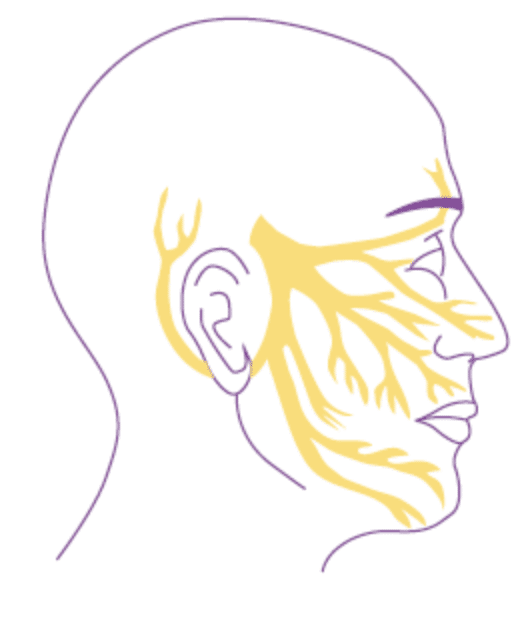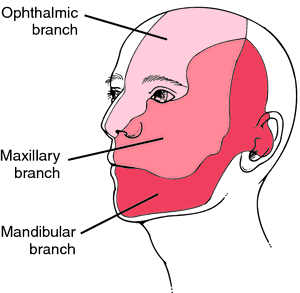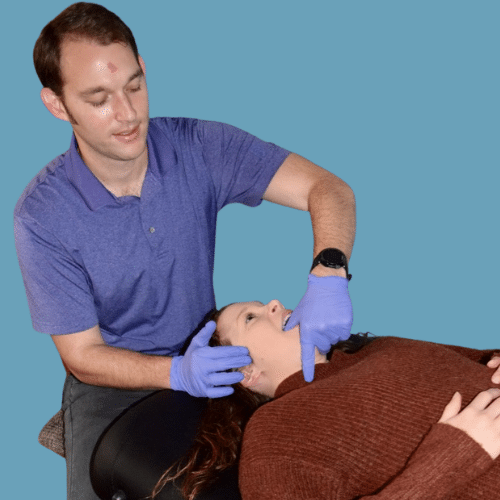Most people have never heard of trigeminal neuralgia. If you have, it was probably because you or a friend experienced an intense electrical shock sensation in their face. This pain can come on suddenly without warning. Those unfortunate enough to experience this pain often say that it may be the worst pain they’ve ever had. Even if the pain goes away, it is a pain that they remember and worry will soon come back.

Trigeminal neuralgia does not only consist of that severe electrical shock to your cheek. Some may never have that type of pain, but rather a sensation of numbness across part of their face. Others may have a burning sensation, tingling, or even just a light sensitivity.
We will discuss what the trigeminal nerve is, what it does, common symptoms of trigeminal neuralgia, and what may cause trigeminal neuralgia. We will also discuss what a physical therapist can do about treating the trigeminal nerve.
Anatomy and Physiology of the Trigeminal Nerve
The Trigeminal nerve is a cranial nerve, meaning that it stems from your brain rather than your spinal cord. Its primary job is to give sensation to your face and to move the chewing muscles of your jaw. There are three branches of the trigeminal nerve: the ophthalmic nerve, the maxillary nerve, and the mandibular nerve. Each branch has a different role that we will look at more closely:

Image from https://mstrust.org.uk/a-z/trigeminal-neuralgia
The ophthalmic nerve gives sensation to your upper face and eye. More specifically, to your eyebrow, forehead, and scalp.
The maxillary nerve gives sensation to your mid face. Your mid face includes your lower eye lid, cheek, upper lip, upper teeth, and palate (roof of your mouth).
The mandibular nerve gives sensation to the inside of your cheek, the front 2/3 of your tongue, your lower teeth, lower lip, and chin. This nerve also controls the muscles of mastication, better known as your chewing muscles. These muscles include the masseter, medial and lateral pterygoid, temporalis, and a number of other smaller, but equally important muscles.
Common Symptoms of Trigeminal Neuralgia
Those suffering from trigeminal neuralgia may have a number of symptoms, which vary from person to person. These include severe pain, sensations of electrical shock, burning, numbness, tingling, and sensitivity to touch. These symptoms are all occurring in the face, either along the forehead, cheek, or jaw line. These symptoms can present in one, two, or all three trigeminal branches. Symptoms are almost always one sided, but in rare instances can occur on both sides of your face.

Trigeminal nerve pain distributions.
Miller-Keane Encyclopedia and Dictionary of Medicine,
Nursing, and Allied Health, Seventh Edition. © 2003 by Saunders, an imprint of Elsevier, Inc
Once present, symptoms can be triggered simply by brushing your teeth, lying on a pillow, or even talking. In some cases, symptoms may also include difficulty chewing and difficulty with mouth opening and closing.
Why Did I Get Trigeminal Neuralgia?
Every individual’s situation is different. People have different symptoms, slightly different anatomy, and different impairments that may lead them down this road to trigeminal neuralgia.
A common area for the nerve to become irritated is at the TMJ itself. Certain parts of the nerve run directly over the mandibular head (part of the TMJ). If the joint is not moving appropriately, it may place the slightest stress to the nerve each time you open your mouth or chew. Over time, all of those little stresses can irritate the nerve, causing heightened nerve sensitivity or inflammation.
The pathway for the trigeminal nerve ventures into the upper aspects of your neck. Having poor mobility and stiffness throughout your neck can cause a similar type of irritation to this nerve.
There are a number of other different muscular and skeletal causes for trigeminal neuralgia. Each arises from a similar origin: poor movement leads to more irritation of the trigeminal nerve. Although onset of symptoms is usually sudden, the cause is often a gradual process occurring over a long period time.
Beyond these musculoskeletal causes, there are varying other reasons for these symptoms to occur. Reasons including stroke, viral infection, nervous system disorders, or stress on the nerve from a tumor or blood vessels. Trauma to the face, neck, or head including surgery can also result in trigeminal neuralgia.
What Can We Do About It?
As mentioned before, everyone is different. Although your symptoms may seem similar to someone else’s, there are always going to be differences in each individual’s situation. So, treatment may also look different for each person.
At The Jaw Therapist, in order to determine a treatment plan, we first perform a thorough evaluation to assess the individual’s jaw, head, neck, shoulders, and mid back. Each of these areas can influence and lead to irritation of the trigeminal nerve. Social behaviors and day to day habits are also critical to discuss as these too can lead to dysfunction.
Examples of habits and behaviors that can be modified in the management of trigeminal neuralgia are sleeping position and frequency of gum chewing.
From the perspective of a doctor of physical therapy, the goal of treatment is to reduce the factors that may be stressing the nerve. If one of your TMJs is stiffer and not moving as well as it typically should, then this can be a stressor to the trigeminal nerve. If you have poor control and coordination of your jaw muscles, then this can cause issues in how you chew and stress the nerve. Having muscle guarding and muscular tension throughout your neck can also result in this irritation. There are many other musculoskeletal factors at play, these just being a few examples.
With trigeminal neuralgia, the nerve can be highly sensitized, meaning that even the slightest movement or sensation can cause immense pain. Part of the treatment plan should focus on utilizing various hands on techniques and exercises that are intended to reduce the stressors of the nerve, which in turn should diminish the sensitivity. Examples: Using hands on techniques to improve the mobility of a stiff TMJ or using massaging techniques to reduce muscle guarding.

Training your body how to move once the nerve stressing factors are reduced is critical in getting the nerve and the trigeminal neuralgia to ease. If the muscles of the jaw and neck are not trained to move appropriately and function as intended, then they will likely return to stressing the trigeminal nerve. That previously stiff TMJ will return to moving poorly and return to irritating the nerve. The stronger and more coordinated the muscles of your jaw and neck, the better you will likely feel! These symptoms CAN go away!

If You Think You Have These Symptoms, Get Help!
Trigeminal neuralgia is not something you should try to manage on your own. It is critical to seek medical care because there are other serious medical diagnoses that may be involved. If you have sudden onset of numbness or tingling in your face, double vision, and slurring of your speech, call 911 or go to your nearest emergency department.
If you have already been told that you do not have a life threatening medical complication then it is time to get help from The Jaw Therapist, a physician, a neurologist, a dentist, or a physical therapist. Any questions, comments, or concerns? Reach out by email, call, or find us on Facebook and Instagram.


